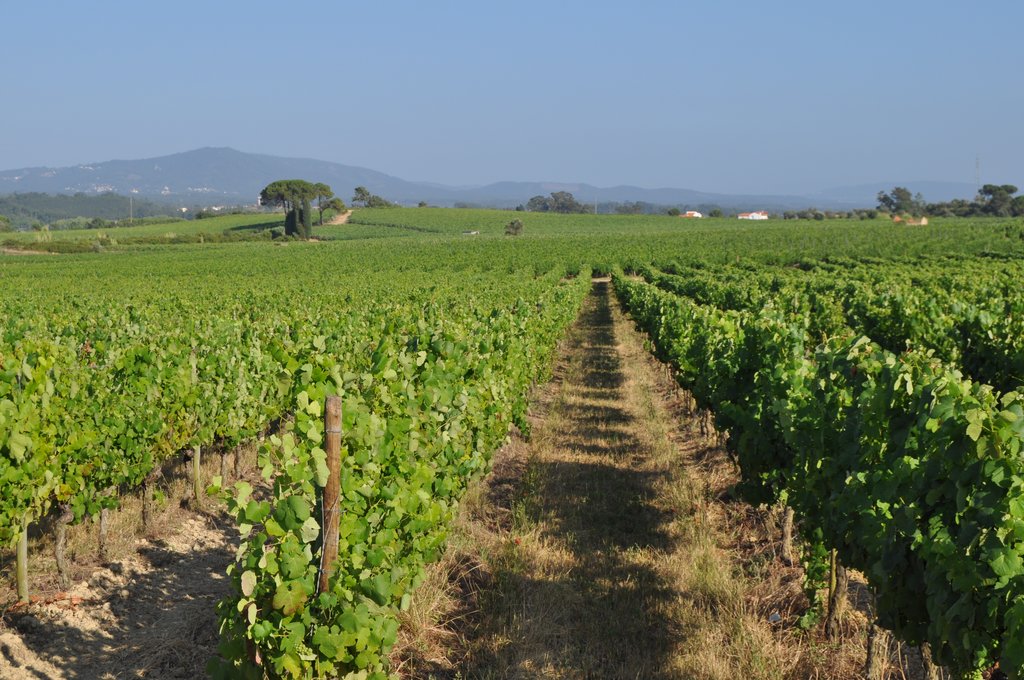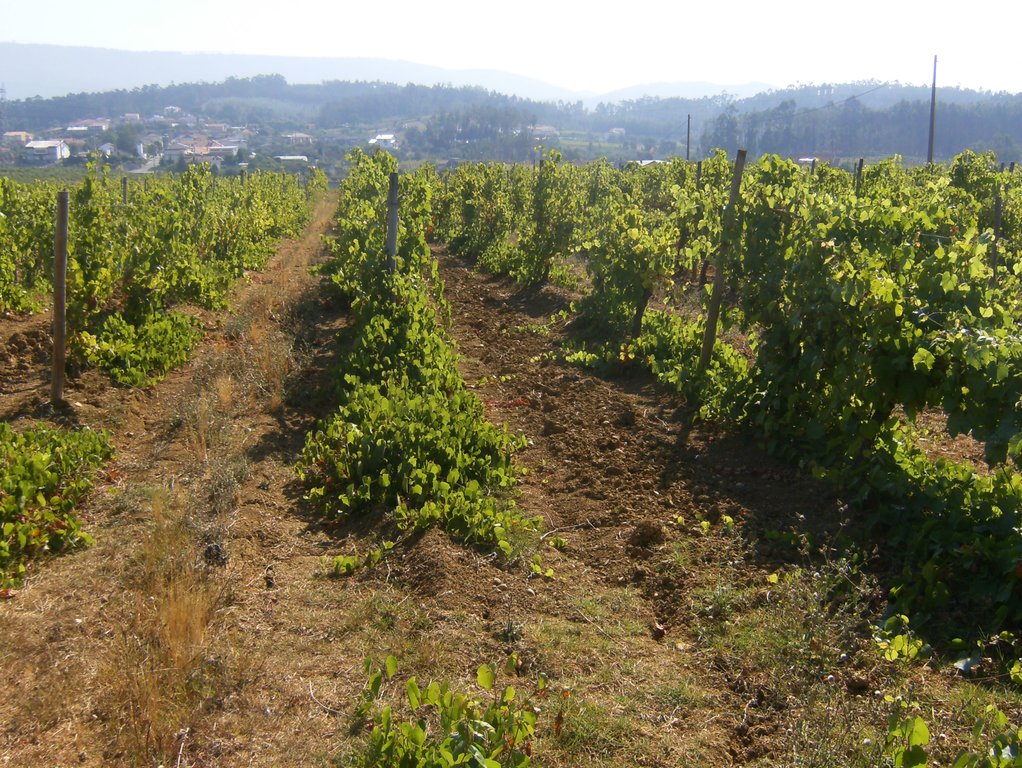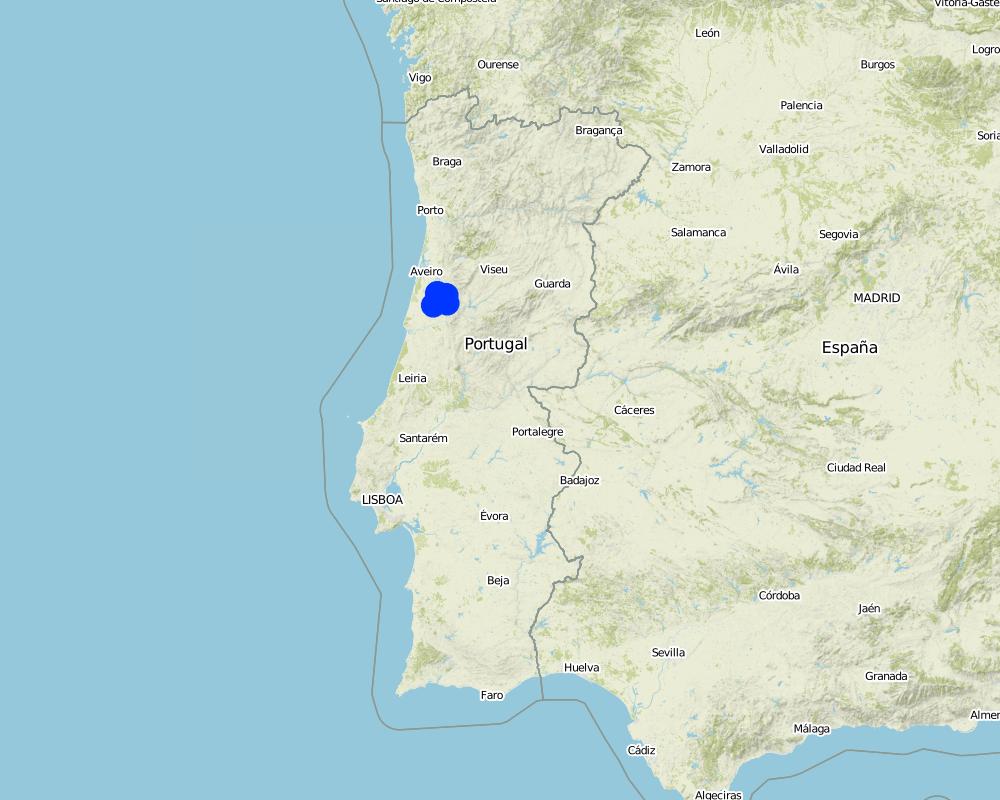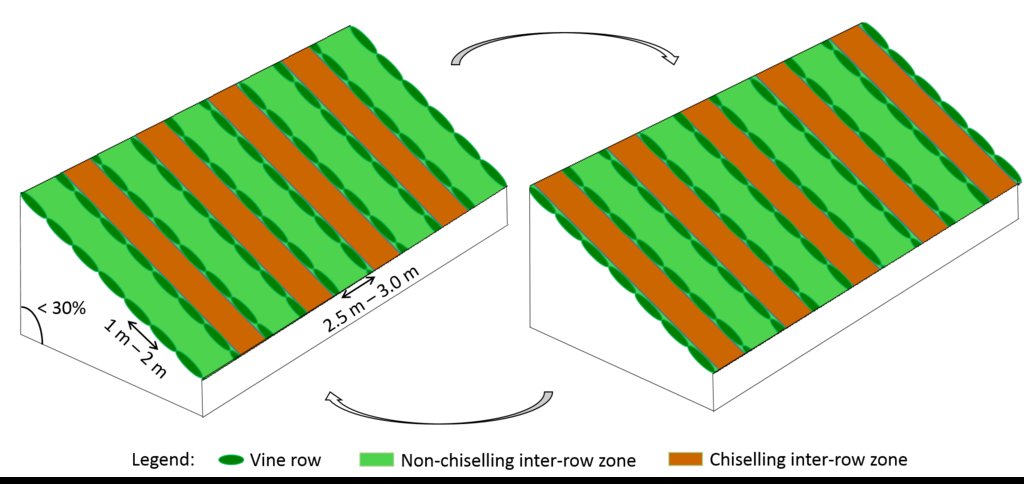Minimum tillage in Mediterranean vineyards [Portugal]
- Creation:
- Update:
- Compiler: Carla Ferreira
- Editor: –
- Reviewers: Ursula Gaemperli, Gudrun Schwilch
Minimum tillage
technologies_2879 - Portugal
View sections
Expand all Collapse all1. General information
1.2 Contact details of resource persons and institutions involved in the assessment and documentation of the Technology
SLM specialist:
Name of project which facilitated the documentation/ evaluation of the Technology (if relevant)
Interactive Soil Quality assessment in Europe and China for Agricultural productivity and Environmental Resilience (EU-iSQAPER)Name of the institution(s) which facilitated the documentation/ evaluation of the Technology (if relevant)
Centro de Estudos de Rescursos Naturais, Ambiente e Sociedade (CERNAS) - Portugal1.3 Conditions regarding the use of data documented through WOCAT
When were the data compiled (in the field)?
01/05/2017
The compiler and key resource person(s) accept the conditions regarding the use of data documented through WOCAT:
Yes
1.4 Declaration on sustainability of the described Technology
Is the Technology described here problematic with regard to land degradation, so that it cannot be declared a sustainable land management technology?
No
2. Description of the SLM Technology
2.1 Short description of the Technology
Definition of the Technology:
Minimum tillage in vineyards is performed in alternated inter-row zone, to promote soil decompation and maintain partial vegetation cover.
2.2 Detailed description of the Technology
Description:
Portugal is one of the larger wine producers in Europe, with vineyard area covering 27% of permanent crops. Vineyards play an important role in the Portuguese economy, not only due to the impact of wine industry but also the important cultural heritage and great influence on tourism sector. There are thirteen specialized wine regions in the country, from which we highlight Bairrada region, located in central mainland, where minimum tillage is becoming popular. Bairrada has a Mediterranean climate, characterized by a long dry summer, although the strong influence of the Atlantic Ocean. Vineyard is the most relevant crop in Bairrada. In this region, farmland is mostly cultivated by landowners, comprising small winegrowers (5-10ha), most of them members of local farmers associations, as well as large producers (100-500ha) with a relevant position in the world wine market.
In vineyards, tillage is performed to promote de-compaction of the typical medium/fine soils and weeds control. In Bairrada wine region, soil tillage is usually performed twice per year – in autumn and spring, depending on weather conditions. Tillage is performed with a ripper and disc arrow (10-15cm), since mechanized vineyards require vines arranged according to horizontal wire bundles. However, tillage activities favour soil degradation, namely due to soil erosion and increasing mineralization of organic matter. In order to mitigate land degradation, minimum tillage of inter-row zone was adopted. No tillage is not applied by the farmers due to the need to de-compact the soil, favoured by the relatively high clay content. The minimum tillage is performed in alternated inter-rows, to keep vegetation cover in part of the vineyard. Tillage inter-row switch every time, so that each inter-row is not tilled more than once per year. Weeds control in the non-tilled inter-rows is performed using a rotary brush mower. In the plant zone, weeds are controlled with herbicides, applied twice per year: autumn-winter (before vine plant winding) and spring-summer (during vegetative growth). During the hot dry summer, weeds are naturally controlled due to water-stress. Mechanical intervention is also performed for pest and disease control, generally applied as preventive measures. Phytosanitary treatments are performed upon receipt of notices from Regional Directorate of Agriculture or technicians from local farmers association. These notices also include recommendations about the type of products and the application rate. In the majority of the Region, pruning and harvesting is performed manually. Pruning residues are typically mowed and left at the soil surface.
The adoption of minimum tillage was triggered by governmental subsidies. Farmers recognize the impact of this technology on the environment, namely on preventing soil degradation and enhancing biodiversity. However, soil compaction and water competition between vegetation cover and vines (over the summer) are major concerns.
2.3 Photos of the Technology
2.5 Country/ region/ locations where the Technology has been applied and which are covered by this assessment
Country:
Portugal
Region/ State/ Province:
Bairrada, Central Region
Map
×2.6 Date of implementation
If precise year is not known, indicate approximate date:
- less than 10 years ago (recently)
2.7 Introduction of the Technology
- motivated by financial support from the government
Comments (type of project, etc.):
Technical recommendations provided by technicians of farmers associations.
3. Classification of the SLM Technology
3.1 Main purpose(s) of the Technology
- reduce, prevent, restore land degradation
3.2 Current land use type(s) where the Technology is applied

Cropland
- Tree and shrub cropping
Main crops (cash and food crops):
Vineyard
3.3 Further information about land use
Water supply for the land on which the Technology is applied:
- rainfed
Number of growing seasons per year:
- 1
Specify:
One harvesting per year
3.4 SLM group to which the Technology belongs
- improved ground/ vegetation cover
- minimal soil disturbance
3.5 Spread of the Technology
Specify the spread of the Technology:
- evenly spread over an area
If the Technology is evenly spread over an area, indicate approximate area covered:
- 100-1,000 km2
3.6 SLM measures comprising the Technology

agronomic measures
- A1: Vegetation/ soil cover
- A3: Soil surface treatment
3.7 Main types of land degradation addressed by the Technology

soil erosion by water
- Wt: loss of topsoil/ surface erosion

physical soil deterioration
- Pc: compaction
3.8 Prevention, reduction, or restoration of land degradation
Specify the goal of the Technology with regard to land degradation:
- reduce land degradation
4. Technical specifications, implementation activities, inputs, and costs
4.1 Technical drawing of the Technology
4.2 Technical specifications/ explanations of technical drawing
Minimum tillage in vineyards is performed in the inter-row zone, in alternated lines switching between chiselling activities (10-15cm), usually performed in autumn and spring. There is no specific technical recommendations.
Vines are disposed horizontally, supported by wire or cord sustained by wood or metal support. Planting compass varies with soil fertility, type of wine, as well as expected quantity and quality of production, and desired height of the edges. Typically, distance between vine plants within each row ranges from 1m to 2m, and the inter-rows distance from 2.5m to 3.0m, leading to densities of 1000-3000 vines/ha. Generally vineyards are installed on natural surface profile for slopes lower than 30%, and in terraces for hillslopes of 30-50%. Vine plantation is forbidden for slopes greater than 50%.
4.3 General information regarding the calculation of inputs and costs
Specify how costs and inputs were calculated:
- per Technology area
Indicate size and area unit:
1 ha per year
other/ national currency (specify):
euro
Indicate exchange rate from USD to local currency (if relevant): 1 USD =:
0.86615
Indicate average wage cost of hired labour per day:
30
4.4 Establishment activities
| Activity | Type of measure | Timing | |
|---|---|---|---|
| 1. | Chiselling of alternated inter-row zone | Agronomic | Autumn/Spring |
| 2. | Mechanical weeds control in alternated inter-row | Agronomic | Autumn/Spring |
| 3. | Chemical control of weeds in plant zone | Agronomic | Autumn-Winter and Spring-Summer |
4.5 Costs and inputs needed for establishment
| Specify input | Unit | Quantity | Costs per Unit | Total costs per input | % of costs borne by land users | |
|---|---|---|---|---|---|---|
| Equipment | Chisel | Equipment | 1.0 | 1000.0 | 1000.0 | 100.0 |
| Equipment | Rotary brush mower | Equipment | 1.0 | 1600.0 | 1600.0 | 100.0 |
| Equipment | Sprayer | Equipment | 1.0 | 2500.0 | 2500.0 | 100.0 |
| Total costs for establishment of the Technology | 5100.0 | |||||
If land user bore less than 100% of costs, indicate who covered the remaining costs:
Young farmers (<40 years old) may submit agricultural projects for partial government funding.
Comments:
The costs provided do not include the tractor aquisition costs.
4.6 Maintenance/ recurrent activities
| Activity | Type of measure | Timing/ frequency | |
|---|---|---|---|
| 1. | Weeds control with herbicides (in vine rows) | Agronomic | Autumn-Winter and Spring-Summer |
| 2. | Mechanical weeds control (inter-row) | Agronomic | Autumn/Spring |
| 3. | Chiselling (inter-row) | Agronomic | Autumn/Spring |
4.7 Costs and inputs needed for maintenance/ recurrent activities (per year)
| Specify input | Unit | Quantity | Costs per Unit | Total costs per input | % of costs borne by land users | |
|---|---|---|---|---|---|---|
| Labour | For chiselling activities | Person-days | 1.0 | 30.0 | 30.0 | 100.0 |
| Labour | For mechanical weed control | Person-days | 1.0 | 30.0 | 30.0 | 100.0 |
| Labour | For spraying of herbicides | Person-days | 1.0 | 30.0 | 30.0 | 100.0 |
| Equipment | Tractor with chisel | 2.0 | 100.0 | 200.0 | 100.0 | |
| Equipment | Tractor with rotary brush mower | 2.0 | 145.0 | 290.0 | 100.0 | |
| Equipment | Tractor with spraying system | 1.0 | 150.0 | 150.0 | 100.0 | |
| Fertilizers and biocides | Herbicides | Litres | 6.0 | 12.0 | 72.0 | 100.0 |
| Total costs for maintenance of the Technology | 802.0 | |||||
4.8 Most important factors affecting the costs
Describe the most determinate factors affecting the costs:
Machinery and labor
5. Natural and human environment
5.1 Climate
Annual rainfall
- < 250 mm
- 251-500 mm
- 501-750 mm
- 751-1,000 mm
- 1,001-1,500 mm
- 1,501-2,000 mm
- 2,001-3,000 mm
- 3,001-4,000 mm
- > 4,000 mm
Specify average annual rainfall (if known), in mm:
1077.00
Specifications/ comments on rainfall:
The climate is Mediterranean but with a significant influence of the Atlantic Ocean. The dry season extends from July to September and the rainiest period extends from November to February.
Indicate the name of the reference meteorological station considered:
10G/01UG from the Sistema Nacional de Informação de Recursos Hídricos
Agro-climatic zone
- sub-humid
Csb according with Köppen climatic classification.
5.2 Topography
Slopes on average:
- flat (0-2%)
- gentle (3-5%)
- moderate (6-10%)
- rolling (11-15%)
- hilly (16-30%)
- steep (31-60%)
- very steep (>60%)
Landforms:
- plateau/plains
- ridges
- mountain slopes
- hill slopes
- footslopes
- valley floors
Altitudinal zone:
- 0-100 m a.s.l.
- 101-500 m a.s.l.
- 501-1,000 m a.s.l.
- 1,001-1,500 m a.s.l.
- 1,501-2,000 m a.s.l.
- 2,001-2,500 m a.s.l.
- 2,501-3,000 m a.s.l.
- 3,001-4,000 m a.s.l.
- > 4,000 m a.s.l.
Indicate if the Technology is specifically applied in:
- not relevant
Comments and further specifications on topography:
Óis do Bairro: 5%; São Lourenço: 10%; Estação Vitivinícola: 9%; Quinta do Valdoeiro: 10%; Pocariça: 14%. Altitude ranges from 25m to 55 m a.s.l.
5.3 Soils
Soil depth on average:
- very shallow (0-20 cm)
- shallow (21-50 cm)
- moderately deep (51-80 cm)
- deep (81-120 cm)
- very deep (> 120 cm)
Soil texture (topsoil):
- medium (loamy, silty)
- fine/ heavy (clay)
Soil texture (> 20 cm below surface):
- medium (loamy, silty)
- fine/ heavy (clay)
Topsoil organic matter:
- medium (1-3%)
- low (<1%)
5.4 Water availability and quality
Ground water table:
5-50 m
Availability of surface water:
poor/ none
Water quality (untreated):
for agricultural use only (irrigation)
Is water salinity a problem?
No
Is flooding of the area occurring?
No
5.5 Biodiversity
Species diversity:
- low
Habitat diversity:
- low
Comments and further specifications on biodiversity:
There is a lack of studies regarding biodiversity.
5.6 Characteristics of land users applying the Technology
Sedentary or nomadic:
- Sedentary
Market orientation of production system:
- mixed (subsistence/ commercial
- commercial/ market
Off-farm income:
- less than 10% of all income
- > 50% of all income
Relative level of wealth:
- average
- rich
Individuals or groups:
- individual/ household
- cooperative
Level of mechanization:
- manual work
- mechanized/ motorized
Gender:
- men
Age of land users:
- middle-aged
- elderly
Indicate other relevant characteristics of the land users:
Some of the farmers belong to large wine companies, which export the wine to several countries
5.7 Average area of land owned or leased by land users applying the Technology
- < 0.5 ha
- 0.5-1 ha
- 1-2 ha
- 2-5 ha
- 5-15 ha
- 15-50 ha
- 50-100 ha
- 100-500 ha
- 500-1,000 ha
- 1,000-10,000 ha
- > 10,000 ha
Is this considered small-, medium- or large-scale (referring to local context)?
- medium-scale
- large-scale
Comments:
The area of land varies a lot. Individual farmers can have vineyards from 2-15ha, whereas large wine companies own up to 400 ha of vineyards in Bairrada region.
5.8 Land ownership, land use rights, and water use rights
Land ownership:
- company
- individual, not titled
Land use rights:
- individual
Water use rights:
- open access (unorganized)
Comments:
The state also own some vineyards devoted to research.
5.9 Access to services and infrastructure
health:
- poor
- moderate
- good
education:
- poor
- moderate
- good
technical assistance:
- poor
- moderate
- good
employment (e.g. off-farm):
- poor
- moderate
- good
markets:
- poor
- moderate
- good
energy:
- poor
- moderate
- good
roads and transport:
- poor
- moderate
- good
drinking water and sanitation:
- poor
- moderate
- good
financial services:
- poor
- moderate
- good
6. Impacts and concluding statements
6.1 On-site impacts the Technology has shown
Socio-economic impacts
Production
land management
Comments/ specify:
There are no measurements.
Water availability and quality
irrigation water quality
Comments/ specify:
Although there are no measurements, it is expected less sediment and nutrient export (linked to decreasing runoff), thus less impacts on aquatic ecossystems.
Income and costs
workload
Comments/ specify:
Associated with decreasing chiseling activities
Socio-cultural impacts
recreational opportunities
Comments/ specify:
Vineyards are relevant for tourism, thus, their sustainability is relevant.
SLM/ land degradation knowledge
Comments/ specify:
Farmers associations provide knowladge and trainning to farmers.
Ecological impacts
Water cycle/ runoff
water quantity
Comments/ specify:
Not measured, but available water in the water cycle is expected.
water quality
Comments/ specify:
There is no data, but decreasing runoff will contribute for lower sediment and nutrient exports, thus, improving water quality.
surface runoff
Soil
soil moisture
Comments/ specify:
There are no measurements, but field studies performed elsewhere report increasing soil moisture due to vegetation cover.
soil cover
Comments/ specify:
Maintenance of vegetation cover in half of the vineyard inter-rows. However, vegetation cover is limited during dry periods.
soil loss
Comments/ specify:
Based on bibliography.
soil compaction
Comments/ specify:
Although there are no measurements, farmers report that ploughing activities are relevant to reduce soil compaction.
soil organic matter/ below ground C
Comments/ specify:
According with literature review, minimum tillage decrease the mineralization of organic matter.
Biodiversity: vegetation, animals
Vegetation cover
Comments/ specify:
Not measured.
beneficial species
Comments/ specify:
Not measured, but expected given the partia maintenance of vegetation cover.
6.2 Off-site impacts the Technology has shown
downstream flooding
Comments/ specify:
Decreasing runoff will contribute for decreasing downstream flooding
downstream siltation
Comments/ specify:
Less runoff and erosion will decrease downstream siltation.
groundwater/ river pollution
Comments/ specify:
Less runoff will provide lower sediment and nutrient exports to rivers.
impact of greenhouse gases
Comments/ specify:
Lower tractor activities contribute for less greenhouse gases emission.
Comments regarding impact assessment:
The impacts have not been measured. The response is based on literature review and field observations.
6.3 Exposure and sensitivity of the Technology to gradual climate change and climate-related extremes/ disasters (as perceived by land users)
Comments:
The technology does not have an impact on climate related issues.
6.4 Cost-benefit analysis
How do the benefits compare with the establishment costs (from land users’ perspective)?
Short-term returns:
neutral/ balanced
Long-term returns:
neutral/ balanced
How do the benefits compare with the maintenance/ recurrent costs (from land users' perspective)?
Short-term returns:
slightly positive
Long-term returns:
slightly positive
6.5 Adoption of the Technology
- 10-50%
Of all those who have adopted the Technology, how many have did so spontaneously, i.e. without receiving any material incentives/ payments?
- 0-10%
6.6 Adaptation
Has the Technology been modified recently to adapt to changing conditions?
No
6.7 Strengths/ advantages/ opportunities of the Technology
| Strengths/ advantages/ opportunities in the land user’s view |
|---|
| Less herbicides and ploughing decreases maintenance costs. |
| It allows to reduce herbicide application to control weeds, thus favouring biodiversity. |
| Strengths/ advantages/ opportunities in the compiler’s or other key resource person’s view |
|---|
| Minimum tillage is best suited for heavy, compacted and/or poorly drained soils, typical of vineyards. |
| It reduces land degradation, by improving soil structure and vegetation cover, important to reduce soil erosion. |
| Improving soil cover will improve soil moisture and aeration conditions, relevant for crop development and soil biodiversity. |
6.8 Weaknesses/ disadvantages/ risks of the Technology and ways of overcoming them
| Weaknesses/ disadvantages/ risks in the land user’s view | How can they be overcome? |
|---|---|
| Soil compaction due to lower ploughing | Improve soil structure |
| Weaknesses/ disadvantages/ risks in the compiler’s or other key resource person’s view | How can they be overcome? |
|---|---|
| Difficulty to maintain inter-row vegetation cover during the dry season | Replace vegetation cover by other materials (e.g. mulching) |
7. References and links
7.1 Methods/ sources of information
- field visits, field surveys
More than 10 field visits were performed over a three month period.
- interviews with land users
Seven
- interviews with SLM specialists/ experts
Two
- compilation from reports and other existing documentation
Several
7.3 Links to relevant information which is available online
Title/ description:
Biddoccu, M., Ferraris, S., Pitacco, A., Cavallo, E. (2017). Temporal variability of soil management effects on soil hydrological properties, runoff and erosion at the field scale in a hillslope vineyard, North-West Italy. Soil & Tillage Research 165, 46–58.
URL:
http://ac.els-cdn.com/S0167198716301386/1-s2.0-S0167198716301386-main.pdf?_tid=22418bb0-5b58-11e7-980c-00000aab0f6c&acdnat=1498582154_0fb04affbfbcf3f6e729ccdd354527ee
Title/ description:
Byrne, S., Guire, L.M. (2005) Vineyard Floor Management. Final report to Grape and Wine Research & Development Corporation (RT 04/03-1)
URL:
http://www.mvwi.com.au/items/526/Vineyard%20Floor%20Management%20RT%2004%2003%201.pdf
Title/ description:
Cruz, A., Botelho, M., Silvestre, J., Castro R. (2012) Soil management: Introduction of tillage in a vineyard with a long-term natural cover. Journal of Viticulture and Enology 27(1), 27-38.
URL:
http://www.scielo.mec.pt/pdf/ctv/v27n1/v27n1a03.pdf
Title/ description:
Napoli, M., Marta, A.D., Zanchi, C.A., Orlandini, S. (2017). Assessment of soil and nutrient losses by runoff under different soil management practices in an Italian hilly vineyard. Soil & Tillage Research 168, 71–80.
URL:
http://ac.els-cdn.com/S0167198716302604/1-s2.0-S0167198716302604-main.pdf?_tid=34c1a784-5b58-11e7-8e6a-00000aacb35d&acdnat=1498582186_a97504bbec990b26b9de92901fae9b9b
Title/ description:
Puig-Montserrat, X., Stefanescu, C., Torre, I., Palet, J., Fàbregas, E., Dantart, J., Arrizabalaga, A., Flaquer, C. (2017). Effects of organic and conventional crop management on vineyard biodiversity. Agriculture, Ecosystems and Environment 243, 19–26.
URL:
http://ac.els-cdn.com/S0167880917301603/1-s2.0-S0167880917301603-main.pdf?_tid=1428ce58-5b58-11e7-a61a-00000aacb361&acdnat=1498582131_0ca1f7a72aa834a0345b38122a2f7a05
Title/ description:
Raclot, D., Bissonnais, Y.L., Louchart, X., Andrieux, P., Moussa, R., Volts, M. (2009). Soil tillage and scale effects on erosion from fields to catchment in a Mediterranean vineyard area. Agriculture, Ecosystems and Environment 134, 201–210.
URL:
http://ac.els-cdn.com/S0167880909002023/1-s2.0-S0167880909002023-main.pdf?_tid=3a75799e-5b58-11e7-8adf-00000aab0f6b&acdnat=1498582195_b808271c0c5bcddc3fa189cccc11fea3
Links and modules
Expand all Collapse allLinks
No links
Modules
No modules







